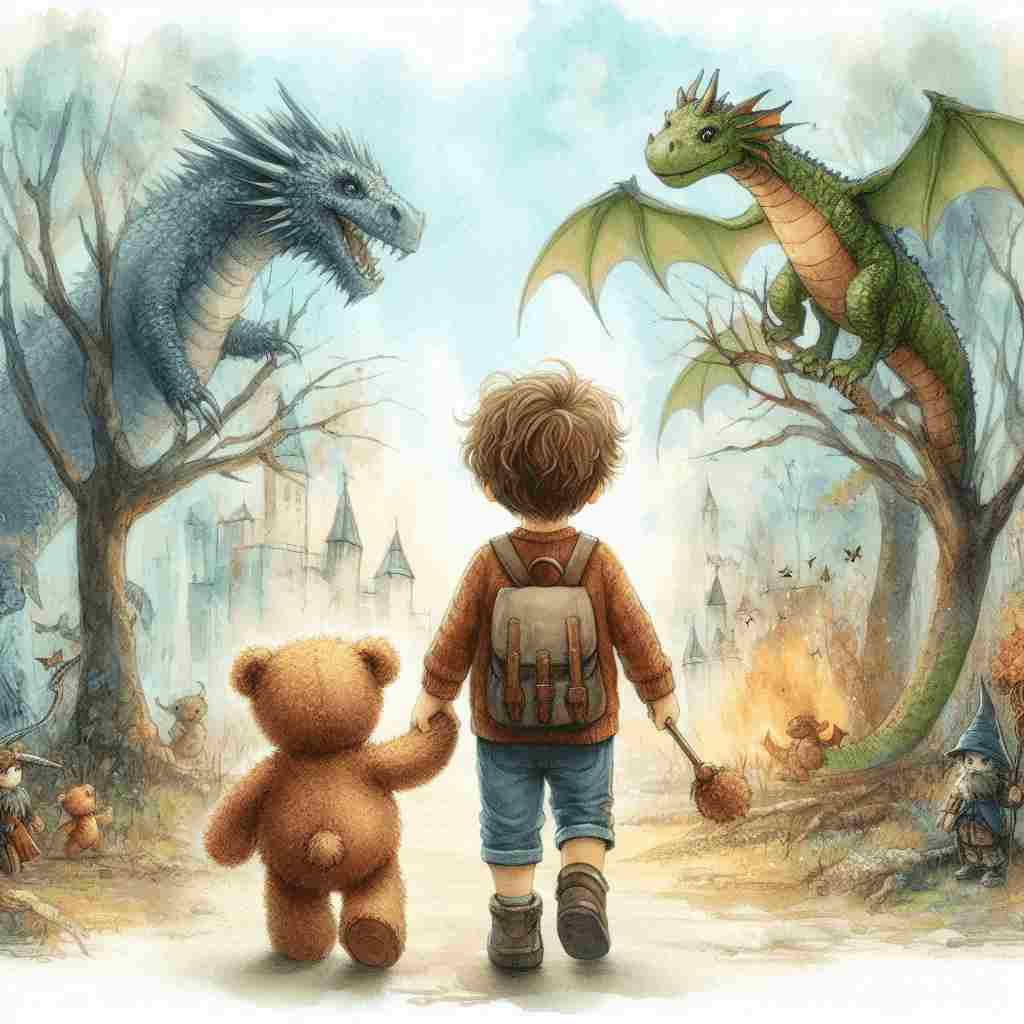Us Two
A. A. Milne
1882 to 1956

Want to track your favorites? Reopen or create a unique username. No personal details are required!
Wherever I am, there's always Pooh,
There's always Pooh and Me.
Whatever I do, he wants to do,
"Where are you going today?" says Pooh:
"Well, that's very odd 'cos I was too.
Let's go together," says Pooh, says he.
"Let's go together," says Pooh.
"What's twice eleven?" I said to Pooh.
("Twice what?" said Pooh to Me.)
"I think it ought to be twenty-two."
"Just what I think myself," said Pooh.
"It wasn't an easy sum to do,
But that's what it is," said Pooh, said he.
"That's what it is," said Pooh.
"Let's look for dragons," I said to Pooh.
"Yes, let's," said Pooh to Me.
We crossed the river and found a few-
"Yes, those are dragons all right," said Pooh.
"As soon as I saw their beaks I knew.
That's what they are," said Pooh, said he.
"That's what they are," said Pooh.
"Let's frighten the dragons," I said to Pooh.
"That's right," said Pooh to Me.
"I'm not afraid," I said to Pooh,
And I held his paw and I shouted "Shoo!
Silly old dragons!"- and off they flew.
"I wasn't afraid," said Pooh, said he,
"I'm never afraid with you."
So wherever I am, there's always Pooh,
There's always Pooh and Me.
"What would I do?" I said to Pooh,
"If it wasn't for you," and Pooh said: "True,
It isn't much fun for One, but Two,
Can stick together, says Pooh, says he. "That's how it is," says Pooh.
A. A. Milne's Us Two
A.A. Milne's poem "Us Two" is a charming exploration of friendship, imagination, and companionship, presented through the lens of the beloved characters Pooh Bear and his human friend, presumably Christopher Robin. The poem's structure, consisting of five stanzas of seven lines each, creates a rhythmic and musical quality that mimics the playful nature of childhood adventures.
The poem opens with a declaration of the inseparable nature of the two friends: "Wherever I am, there's always Pooh, / There's always Pooh and Me." This sets the tone for the entire piece, emphasizing the constant presence and unwavering support that characterizes their relationship. The use of capitalization in "Pooh" and "Me" personifies both characters, giving them equal importance in the narrative.
Milne employs a call-and-response technique throughout the poem, with the human initiating actions or posing questions, and Pooh eagerly agreeing or supporting. This technique not only reinforces the idea of their close bond but also creates a sense of dialogue and interaction within the poem itself. The repetition of phrases like "says Pooh, says he" and variations thereof serves to punctuate each stanza, creating a comforting rhythm reminiscent of a nursery rhyme.
The second stanza introduces an element of intellectual play, with the human asking Pooh a mathematical question. The humor in this exchange lies in Pooh's confident agreement with the answer, despite his initial confusion ("Twice what?" said Pooh to Me). This interaction showcases the unconditional support and validation that friends offer each other, even in moments of uncertainty.
The third and fourth stanzas delve into the realm of imagination, with the friends embarking on a dragon-hunting adventure. The ease with which they transition from everyday activities to fantastical quests highlights the power of childhood imagination and the role of friendship in fostering creativity. The identification of dragons by their "beaks" adds a touch of innocent misunderstanding, further emphasizing the childlike perspective of the narrative.
The fourth stanza also introduces an element of bravery, with the friends confronting the imaginary dragons. The line "I'm not afraid," repeated by both the human and Pooh, underscores the courage that friendship can inspire. This theme reaches its culmination in Pooh's declaration, "I'm never afraid with you," a powerful statement about the security and confidence that a strong friendship provides.
The final stanza brings the poem full circle, echoing the opening lines but adding a new layer of depth. The question "What would I do?" followed by "If it wasn't for you" expresses gratitude and acknowledges the essential nature of their friendship. Pooh's response, "It isn't much fun for One, but Two, / Can stick together," encapsulates the central theme of the poem: the joy and strength found in companionship.
Throughout the poem, Milne uses simple language and concepts, reflecting the perspective of a child. However, this simplicity belies the deeper themes at play. The poem touches on concepts such as mutual support, shared imagination, the bolstering of confidence, and the fundamental human need for connection.
The consistent rhyme scheme (ABCCCCA) and the use of internal rhymes (e.g., "do" and "Pooh") contribute to the poem's musicality and make it memorable - qualities that are particularly appealing to children but also resonate with adults who can appreciate the underlying sentiments.
In conclusion, "Us Two" is more than just a whimsical children's poem. It is a celebration of friendship in its purest form, capturing the essence of unconditional love, support, and shared adventures. Milne's genius lies in his ability to convey profound truths about human relationships through the simple interactions of a boy and his teddy bear, creating a work that continues to charm and inspire readers of all ages.
This text was generated by AI and is for reference only. Learn more

